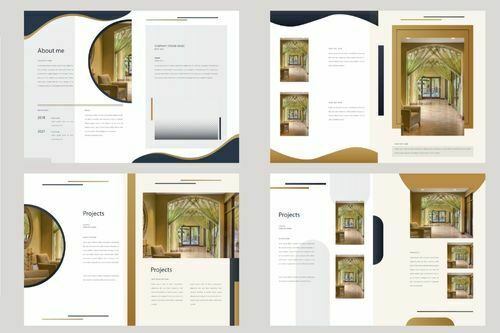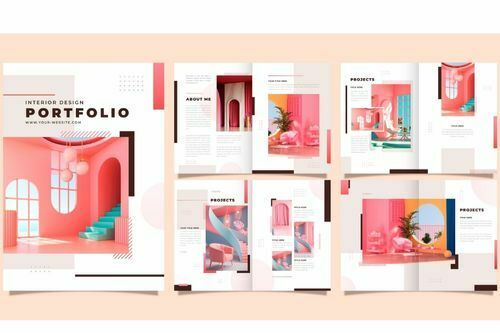Table of Contents
Gaining an architectural position within a practice or an architecture school placement at a college or university is nearly impossible without a portfolio. Remember that your architecture portfolio reflects your personality, attitude, and worldview, so be yourself and follow simple guidelines to get the most out of it.
What is an architecture portfolio?

A portfolio is a tool used to present and demonstrate the skills and services that an architect (or architecture student) can provide to a potential employer, whether for a position in an architectural firm or a private project directly related to a client.
It is doubtful that any employer will offer recruitment or a position without first reviewing the applicant’s portfolio. Because it is the only item that can physically demonstrate their abilities and provide a certain level of assurance that they are capable of carrying out the work required.
What should your portfolio reflect?
An architecture portfolio should show and present a clear image of the range, amount, and distinctiveness of your architectural skills, knowledge, and current experience to the person reading it. As a result, the portfolio must fully demonstrate your capability and expertise in each phase of a project’s development.
You should treat your portfolio as a personal statement, presenting the type of work you do and the methods used to get there, demonstrating how you see things, and showing the kind of designer you are. You must populate it with your best and most recent work.
How to create an architecture portfolio?
For those who have never created an architecture portfolio or are looking for ideas to enhance their current one, the following eight steps outline show how to prepare best and develop a brand-new architectural portfolio-
1. Choose your project
You should aim to show only your best and most pertinent work, which could be customized to the audience viewing your portfolio or a collection of successful projects and experiences.
You are (and must) prove your talent, so careful selection is essential. The projects you choose should clearly show your range of skills and diversity of experience and be accessible to present in various media.
2. Select the best drawings and images
As previously stated, the mediums you present your work are just as important as the drawings themselves; diversification is essential to showcase your diverse skills and talents.
When choosing your drawings and images, aim for quality rather than quantity; one well-produced and presented drawing or illustration is far more impactful than five average examples.
If you choose to present handmade drawings, ensure your scanner is high quality. If necessary, you can take your pictures to a print shop and have them professionally scanned.
3. Decide a format
Your portfolio should be centered on A3 sheet size, as anything larger becomes too cumbersome to carry and physically present, and anything smaller becomes too constrained.
Many practices and institutions will require you to send a sample or the entire document via email before being selected for an interview. An A3 document allows you to easily print to scale or downsize to an A4 without too much trouble or detail loss.
4. Architecture portfolio template

Creating an architecture template unifies your portfolio and ensures consistency for the viewer. It also makes the entire framework process much easier and more efficient, as you are effectively creating a concept for your portfolio.
The overall layout is up to you, but remember not to overcrowd your pages with information; less is more here, and quality over quantity!
We believe a simple white background is best unless a specific project specifies otherwise. However, be careful not to overburden your work.
You can use programs like Photoshop, Illustrator, and Adobe InDesign, the best desktop program for organizing and producing documents like these.
5. Visual impact is important
The sequence in which you arrange your portfolio should be sequential and showcase each of your core skills.
Order and neatness are essential in telling the story of your professional development and career to date.
This process takes time, so it should not be rushed or left until the last minute. Ideally, you should create several rough drafts, ask your peers, solicit feedback, and ask for viewpoints.
6. Create a front cover
The front cover of your portfolio will give the viewer a first impression of your work, so keep it simple.
At the very least, the front cover should include a title and your full name. You may also want to mention your college or university (if you are a student) and your academic or professional status.
The inside cover and adjacent pages are ideal places to include your CV/resume, forming one complete and concise document that will be useful to the interviewer both during and after the interview.
7. Create a file
Some workspaces or colleges still prefer to send hard copies of portfolios via postal mail and will refuse to view anything that is not. Others are the polar opposite, so carefully read the submission requirements.
If you send your portfolio in PDF format, ensure the file size is no more than 10MB (15MB maximum), so you can effortlessly send it via email.
8. Cover letter
Finally, to add a final professional touch to your portfolio, include a personalized cover letter with each submission.
It does not have to be an in-depth analysis of why you appreciate their work, but you should address the specific (and correct) person.
Portfolios addressed to ‘Dear Sir or Madam’ or ‘To whom it may concern are incredibly impersonal, implying that the person reading it is just one of many. So, please figure out who to address it to so that you have the best chance of getting through.
Key takeaways
- Your architecture portfolio is a mirror of your hard work and accomplishments.
- Make a precise architecture template with all the necessary graphics, drawings, and images. It is a crucial part of your portfolio.
- You must create a visual impact throughout your portfolio. The employer must pick your portfolio without any hesitation.
- Your cover letter for the architecture portfolio should address the correct person so your chances of acceptance increase.
Did you find this blog informative? If so, please share your thoughts in the comments below. Click here to contact us for more information on the architecture portfolio. We would be happy to assist you with your queries.
Liked this blog? Read next: Top 10 architecture scholarships abroad
FAQs
Q1. How do you create an online architecture portfolio?
Answer- There are numerous free and paid options for creating your online portfolio. The best websites provide easily customizable paid alternatives.
Q2. What are the different types of portfolios?
Answer- The Aggressive, Defense, Income, Speculative, and Hybrid portfolios are different types of portfolios.
Q3. Should an architecture portfolio be portrait or landscape?
Answer- The majority of architectural portfolios are in landscape format. To maintain legibility, one should limit font types to no more than three.







